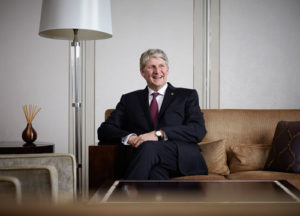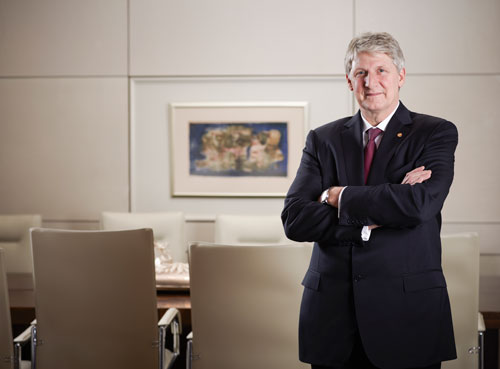Who can best cater to the new generation with a lifestyle brand? Leave it to a luxury hotel company, says Robert Warman, the new CEO of Langham Hospitality Group. He tells Raini Hamdi why he’s upbeat about a repositioned Eaton
 I hear you have a war chest of US$1.5 billion and that you intend to take the company from 22 hotels now to 100 hotels in five years, then 500 in 10 years!
I hear you have a war chest of US$1.5 billion and that you intend to take the company from 22 hotels now to 100 hotels in five years, then 500 in 10 years!
We’re taking a dual approach: third-party management contracts and strategic real estate. We think we will acquire a decent number of hotels, but what the total amounts to is always hard to say.
We would love to be in Singapore and our parent, Great Eagle Holdings, would also very much like to invest in hospitality real estate in Singapore, which has been a strong market and will continue to be so in the long term although there’s a tiny bit of a slowdown now.
We reported in 2012 Langham was in talks for a hotel in Singapore but nothing’s happened. What are the issues?
Finding land, the right location – in our business we talk to many people and it takes time for the right deal to materialise.
We’re also interested to expand in Europe and North America, where we’re currently in negotiation for three and two hotels, respectively.
And like we did with our Langham brand, we will also support the launch of our brand, Eaton, with our own capital.
But Eaton’s been launched.
We’re repositioning Eaton to become a lifestyle brand. Our existing Eaton hotels will undergo renovations to match that concept. We’ll announce the DNA of the new Eaton soon and by then I believe we’ll also be able to announce at least five new-generation Eaton hotels, either renovated or new-builds, four of them city hotels and one resort, in international destinations. We believe we’ll have 25 to 30 Eaton hotels in five years.
What is your idea of a lifestyle brand?
It’s a brand targeted at those born after 1985 (Millennials or Gen Y’ers). What’s unique about these customers is they grew up in fairly well-to-do-families, are well-educated, have a lot of disposable income because they don’t bog themselves down with commitments and are used to travelling, staying at five-star or luxury hotels, going to good restaurants, so they know what good service and good F&B are.
They want this same lifestyle but in a different environment. Don’t fool yourself that they want less service – some hotels actually believe they don’t want you to say hello to them! They do, but it does not have to be formal. They still expect people to be friendly; they still have expectations on how long they should wait in line for service, etc.
It’s like when when they buy blue jeans, they still want good design, good product and friendly service. The jeans will cost more than a suit pants and sometimes it’s got holes in them and you can’t wash them (laughs).
So the hotel itself needs to be designed differently. When I wake up in a hotel, I make a cup of coffee or expect the hotel to have the ability to deliver coffee in 15 minutes. I take my hardcopy newspapers and spend an hour reading before I leave for my meeting. So my room needs to have a coffee machine, chair and couch.They wake up, roll out of bed, go to the lobby to grab a cup of coffee and a Danish, read all the pertinent news that have been sent to them on their hand-held devices, do work and relate to people just like them in the lobby. So hotels require different areas of importance for this group.
We’re the only luxury hotel company that is launching a lifestyle brand. There are small companies that do it, but we have the infrastructure that can support that growth. Other bigger chains have a lifestyle brand but they are not luxury hotel companies. We think our understanding of service and the customer will make a difference.
Are hotel companies imagining the need for a lifestyle brand?
Let’s face it, there are two major influences hitting the world, one, the Chinese traveller – you can’t ignore the one billion that have not travelled yet (Langham is launching a China brand, TTG Asia, August 22, 2014) – and the other is the younger generation travellers and the reason is they can afford the product and demand it. On top of that, the companies they work for – the Googles and the Alibabas – are just like them and will move their corporate and meetings business out of the traditional hotels to where their employees are staying.
What does the name Eaton mean?
It means what we create (it to be).
Was the DNA decided before you joined Langham in March?
There were discussions. Part of my joining is to help the company expand internationally. Ultimately, we would like to be a hotel company that has multiple brands globally and be recognised as being among the best in each of the segments.
By now you would have Eaton’s brand specifications. Do share.
The room size will be small, say, on average 30m2 as, as discussed, these customers do not use the room, don’t need that couch, chair, table. In the luxury market (Warman was 18 years with Ritz-Carlton Hotel Company), we build big rooms and leave a large part of them empty! I think at some point in time people will stop building big rooms, even in the luxury segment.
Yet, the lobby area will be much bigger with a community/social hub area, a technology area, a little bakery where they can grab coffee/Danish if they need a snack, a bar and a restaurant. As mentioned, we don’t see this person as economy.
And in the right location, based on space, we’ll also do meeting rooms because, again, we think the companies that employ this generation of people are going to look to hold their meetings where their people are comfortable to be in.
It was the same phenomenon with the luxury market years ago when the senior executives wanted to stay in luxury hotels and corporates then started migrating their meetings to these properties. What fuelled the growth of luxury hotels was the fact there were more markets for them, not just high net worth individuals going on holidays but the corporate market, then the corporate meetings market.
With Eaton, we also don’t believe it’s a one-design-fits-all. Whereas the luxury customer wants some sense of place, this person wants to understand the neighbourhood of where they are staying.
Isn’t that the same?
No, the luxury customer wants to get a glimpse of who a Singaporean is when he goes to a luxury hotel. This new customer wants to stay in the neighbourhood and live that environment – go to the bars and restaurants locals go – they want to hang out with it.
So if everyone is looking at a lifestyle brand,  how do you win?
how do you win?
By delivering more consistently what this traveller wants. And that has to do with design, service, F&B and the environment. For the luxury market and the lifestyle market, it’s the same: who can deliver more consistently than the next guy wins.
Langham has 22 hotels now and you’re talking of leapfrogging that to 100, then 500. What’s changed?
Our parent decided that hospitality management and real estate in the hotel business are a good long-term investment.
A lot of owners think likewise. Doesn’t this explosion of hotels, brands and models worry you?
A lesson I learnt from a previous boss was that a recession and additional competition are pretty much the same thing.
In a recession, people don’t stop to go out and eat. They do cut back on how many times they go out. The question is, do they cut you or someone else out? If they don’t cut you out, you don’t have a recession. Same thing with more hotels or brands opening up. What scares me is not another hotel opening next door, it is, when a guest walks out, does he want to come back to me? It’s really down to the question: do I do it better than my competition? And I can’t look at what’s done in the past. I have to stay relevant by understanding what the new customer expectations are. Plus, the market is growing all the time – we spoke about the one billion Chinese that have not travelled and there are many other such markets. Thirty years ago, people said luxury was dead. At the time Ritz-Carlton probably had five hotels and Four Seasons 10 hotels. Now they have 100 hotels collectively, despite the entry of other luxury brands.
This article was first published in TTG Asia, September 26, 2014 issue, on page 12. To read more, please view our digital edition or click here to subscribe




















